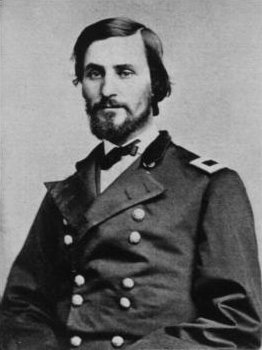William Sooy Smith
|
William Sooy Smith
|
|
|---|---|

William Sooy Smith
|
|
| Born | July 22, 1830 Tarlton, Ohio |
| Died | Script error: The function "death_date_and_age" does not exist. Medford, Oregon |
| Place of burial | |
| Allegiance | United States of America Union |
| Service/ |
United States Army Union Army |
| Years of service | 1853–1854; 1861–1864 |
| Rank | |
| Commands held | 13th Ohio Infantry |
| Battles/wars | American Civil War |
William Sooy Smith (July 22, 1830 – March 4, 1916) was a West Point graduate and career United States Army officer who rose through the ranks to become a major general in the Union Army during the American Civil War.
In civilian life, he was a renowned engineer involved in bridge construction that included the building of the first large all steel bridge in the world.[1]
Contents
Early life and career
Smith was born in Tarlton, Ohio, and graduated from Ohio University in 1849 with an engineering degree. He furthered this degree at West Point as soon as he left the university, graduating sixth in his class from the U.S. Military Academy in 1853. Smith resigned from the Army on June 19, 1854 to accept a position with the Illinois Central Railroad.
Smith established the engineering company Parkinson & Smith in 1857, and was involved in the first surveys for a bridge between the United States and Canada across the Niagara River near Niagara Falls.
Civil War
In 1861 at the outbreak of the Civil War, Smith joined the 13th Ohio Infantry, and by June he was commissioned as its colonel. After serving in western Virginia, he was promoted to brigadier general (volunteers) in April 1862 during the Battle of Shiloh.[1] Smith participated in the Vicksburg campaign, commanding the XVI Corps' first division.[1]
On January 27, 1864, during Union attacks on Meridian, Mississippi, Smith was given the command of General Hurlbut's force of 7,000 cavalry[1] along with the 2,500 that was already under his command. Confederate forces under Maj. Gen. Nathan Bedford Forrest, however, defeated these forces on February 22, 1864 in the Battle of Okolona. Smith, having disobeyed orders from Sherman, was forced to fight this eleven-mile running battle before retreating across the state line into Tennessee on February 26, where he was criticized for putting Sherman's Meridian Expedition in danger.[2]
Afterwards, he served as chief of cavalry in both the Department of Tennessee and the Military Division of Mississippi, under Ulysses S. Grant and William T. Sherman.[1] He resigned from the Army in July 1864 due to rheumatoid arthritis.
Postbellum career
After leaving the army Smith returned to civil engineering. In 1867, he sank the first pneumatic caisson of the Waugoshanee lighthouse in the Straits of Mackinaw. At Glasgow, Missouri, from 1878 to 1879, Smith worked on the Glasgow Railroad Bridge. This was the first all-steel bridge, which crossed the Missouri River.[1]
In 1876 Smith was awarded the American Centennial Exposition prize, and continued to work in engineering until retirement to Medford, Oregon towards the end of his life.[1] After his death in 1916, he was buried in Forest Home Cemetery in Forest Park, Illinois.
-
Williamsmithlaterlife.jpg
Smith in later life.
See also
References
External links
Lua error in package.lua at line 80: module 'strict' not found.